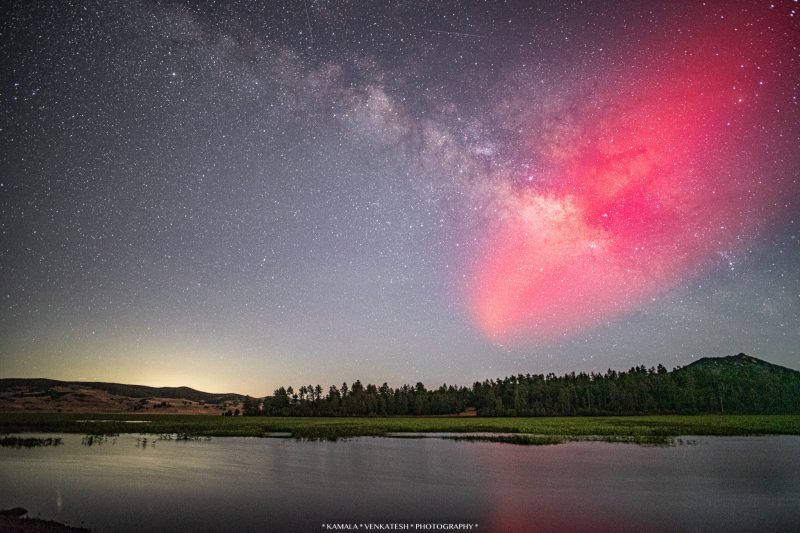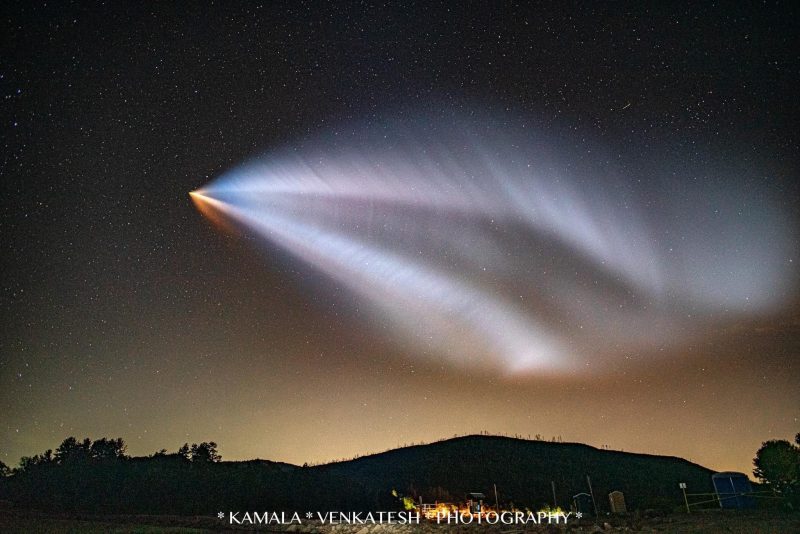
A SpaceX Starlink launch on July 19, 2023, punched a hole in the ionosphere, a layer of Earth’s atmosphere. While this is nothing new in the space age, the red glow created in the aftermath drew the attention of astrophotographers. The SpaceX Starlink launch in question left Vandenberg Space Force Base in California at 9:09 p.m. PDT on July 19, 2023. The rocket plume at launch made for quite a sight as it lit up a portion of the darkening sky (see image below). Shortly after the rocket disappeared, a red glowing blob appeared. As Tony Phillips at Spaceweather.com explained, punching a hole in the ionosphere is something SpaceX and others have been doing for years.
SpaceX launch creates quite a sight
SpaceX Starlink launches are controversial, as they fill near-Earth orbit with ever more satellites. But there’s no denying they put on quite a show. From the bright plume that trails behind the evening rocket launches to the train of lights that cross the sky as the satellites travel to higher orbit, they garner a lot of attention.
And you can add a red, glowing blob to the list of phenomena that astrophotographers might capture after a SpaceX launch. Just last summer, a SpaceX launch from Florida punched a hole in the ionosphere that photographers on the East Coast caught in their images. Some at first thought their cameras were picking up an aurora.
What does it mean to punch a hole in the ionosphere?
Spaceweather.com talked with Jeff Baumgardner of Boston University for a thorough explanation of what the rocket is doing to the ionosphere. Baumgardner told Spaceweather.com:
This is a well-studied phenomenon when rockets are burning their engines 200 to 300 kilometers [125 to 185 miles] above Earth’s surface. The red glow appears when exhaust gases from the rocket’s 2nd stage cause the ionosphere to recombine quickly.
Spaceweather.com elaborated:
Rocket engines spray water (H2O) and carbon dioxide (CO2) into the ionosphere, quenching local ionization by as much as 70%. A complicated series of charge exchange reactions between oxygen ions (O+) and molecules from the rocket exhaust produce photons at a wavelength of 6300 Å … the same color as red auroras.
Baumgardner also said:
I reviewed footage from the July 19th launch. It shows the second stage engine burning at 286 kilometers [177 mi] near the ionosphere’s F-region peak for that time of day. So, it is quite possible that an ionospheric ‘hole’ was made.
Is punching a hole in the ionosphere harmful? Again, Spaceweather.com had the answer:
Ham radio operators may notice [holes in the ionosphere] when shortwave signals fail to skip over the horizon, shooting through holes instead of bouncing back to Earth. Sudden GPS errors can also result from the anomalies. These effects may be troublesome, but they are short-lived; re-ionization occurs as soon as the sun comes up again.
More SpaceX launch photos from the EarthSky Community
Marybeth Kiczenski also captured both the white glow from the SpaceX launch and the red blob in the ionosphere afterward.

Here’s the shot that Kamala captured of Starlink rocketing into space before the red blob appeared on her photos.

Bottom line: On July 19, 2023, astrophotographers captured a strange red blob in their images, which turned out to be a SpaceX launch punching a hole in the ionosphere.
The post SpaceX launch punches a hole in the ionosphere first appeared on EarthSky.
from EarthSky https://ift.tt/StGHzej

A SpaceX Starlink launch on July 19, 2023, punched a hole in the ionosphere, a layer of Earth’s atmosphere. While this is nothing new in the space age, the red glow created in the aftermath drew the attention of astrophotographers. The SpaceX Starlink launch in question left Vandenberg Space Force Base in California at 9:09 p.m. PDT on July 19, 2023. The rocket plume at launch made for quite a sight as it lit up a portion of the darkening sky (see image below). Shortly after the rocket disappeared, a red glowing blob appeared. As Tony Phillips at Spaceweather.com explained, punching a hole in the ionosphere is something SpaceX and others have been doing for years.
SpaceX launch creates quite a sight
SpaceX Starlink launches are controversial, as they fill near-Earth orbit with ever more satellites. But there’s no denying they put on quite a show. From the bright plume that trails behind the evening rocket launches to the train of lights that cross the sky as the satellites travel to higher orbit, they garner a lot of attention.
And you can add a red, glowing blob to the list of phenomena that astrophotographers might capture after a SpaceX launch. Just last summer, a SpaceX launch from Florida punched a hole in the ionosphere that photographers on the East Coast caught in their images. Some at first thought their cameras were picking up an aurora.
What does it mean to punch a hole in the ionosphere?
Spaceweather.com talked with Jeff Baumgardner of Boston University for a thorough explanation of what the rocket is doing to the ionosphere. Baumgardner told Spaceweather.com:
This is a well-studied phenomenon when rockets are burning their engines 200 to 300 kilometers [125 to 185 miles] above Earth’s surface. The red glow appears when exhaust gases from the rocket’s 2nd stage cause the ionosphere to recombine quickly.
Spaceweather.com elaborated:
Rocket engines spray water (H2O) and carbon dioxide (CO2) into the ionosphere, quenching local ionization by as much as 70%. A complicated series of charge exchange reactions between oxygen ions (O+) and molecules from the rocket exhaust produce photons at a wavelength of 6300 Å … the same color as red auroras.
Baumgardner also said:
I reviewed footage from the July 19th launch. It shows the second stage engine burning at 286 kilometers [177 mi] near the ionosphere’s F-region peak for that time of day. So, it is quite possible that an ionospheric ‘hole’ was made.
Is punching a hole in the ionosphere harmful? Again, Spaceweather.com had the answer:
Ham radio operators may notice [holes in the ionosphere] when shortwave signals fail to skip over the horizon, shooting through holes instead of bouncing back to Earth. Sudden GPS errors can also result from the anomalies. These effects may be troublesome, but they are short-lived; re-ionization occurs as soon as the sun comes up again.
More SpaceX launch photos from the EarthSky Community
Marybeth Kiczenski also captured both the white glow from the SpaceX launch and the red blob in the ionosphere afterward.

Here’s the shot that Kamala captured of Starlink rocketing into space before the red blob appeared on her photos.

Bottom line: On July 19, 2023, astrophotographers captured a strange red blob in their images, which turned out to be a SpaceX launch punching a hole in the ionosphere.
The post SpaceX launch punches a hole in the ionosphere first appeared on EarthSky.
from EarthSky https://ift.tt/StGHzej

Aucun commentaire:
Enregistrer un commentaire